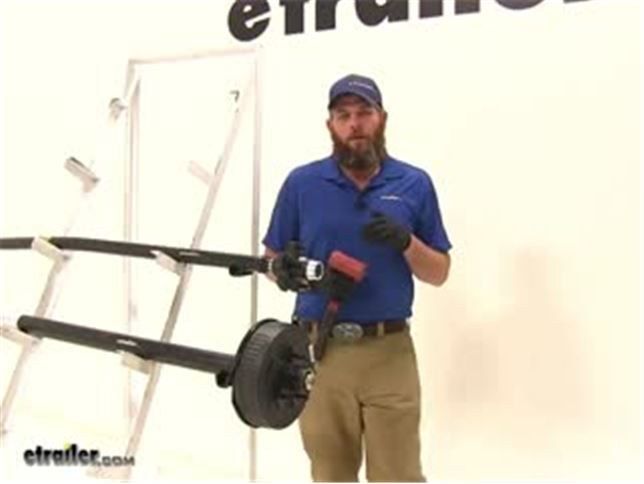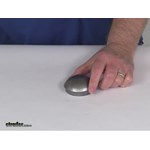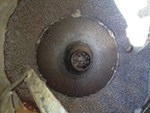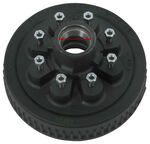
Fulton Grease Cap - 2.333" Outer Diameter - Drive In

Thank you! Your comment has been submitted successfully. You should be able to view your question/comment here within a few days.
Error submitting comment. Please try again momentarily.
- All Info
- Reviews (50)
- Q & A (0)
- Videos (2)
- Photos
Fulton Trailer Bearings Races Seals Caps - F001601
- Caps
- Standard Grease Cap
- 2.333 Inch O.D.
- Fulton
Grease cap fits trailer hubs with 2.333" inner diameter.
Features:
- Grease cap for trailer hubs
- Drive-in installation
- 16-Gauge steel construction
Specs:
- Quantity:1
- Flange diameter: 2.333"
- Crown height: 0.91"
- Flange length: 0.37"
- Overall height: 1.281"
Dimensional Information

| Part No. | Material Gauge | Flange Diameter (A) | Crown Height (B) | Flange Length (C) | Overall Height (D) |
|---|---|---|---|---|---|
| 1600 Series | |||||
| F001601 | 16 | 2.333" | 0.91" | 0.37" | 1.281" |
001601 Fulton Grease Cap, 2.333" x 0.37" Flange
California residents: click here


Videos are provided as a guide only. Refer to manufacturer installation instructions and specs for complete information.
Video Transcript for Trailer Bearings Races Seals and Caps Rebuild
Speaker 1: Today we're going to take you through the rebuild process on a couple of hubs. We've got an idler hub, and here we've got a hub and drum assembly. Works with electric rigs, but this can also work for just standard discs, if you've got a disc brake style setup.Basically what we're going to show you is how to get all of the bearings out. How to remove the seal. How to remove the race's if they're damaged, then get them replaced in the proper manner. We'll show you how to use an easy loop hub, which we have here.The first thing we are going to need to do is, get the grease cap off the end.
It can have either a rubber plug in it like this one does, or it can be a solid metal cap.These are pressed fit in there, basically by tapping on them on the back side. To remove them, a deadbolt hammer is typically what we're going to use. We're just going to start tapping as we go around. You'll see a little separation start right here, and slowly it'll work it's way off.Now the next step's going to vary a little bit depending on your axle setup. Do you see this is going to have a keeper that goes around the nut.
And that prevents that from being backed off, or removed. A lot of times you'll have a castle nut, which will have just little tabs that stick off, and there will be a cotter pin that passes through it. Just depending on your application, you need to get the keeper for the nut off. This style we just kind of pry out. A cotter pin you would just remove of course.Once we have that off ...
We'll start to take off the nut here, and the washer that's in behind it. Now yours should look a whole lot more dirty than this. There should be a lot of grease packed in, and through the hub, this one's brand new. We thought it'd be nice to show you the components before the grease was on .. Of our washer that comes off.And then here we're going to have our outer bearing.
Continue to pull that. We're gonig to have our inner bearing here. That sits in the backside of the hub. And we didn't put it in yet, we will show you how to put it in. But a seal would typically be covering the backside here. We'll show you how to use a seal removal tool, or another tool. To get that pried up and out. To get an access to that inner bearing.Now for a drum style like this, that process for disassembly is going to be just the same. One thing to keep in mind if you're using a disc brake setup. You'll have to remove the caliper before the disc is going to come off.Now once we have the spindle exposed, as we said this is going to be really greasy. We want to get all the grease removed, and the first thing we'll do is inspect it. We want to make sure that it looks just like what we have here. Everything's nice and smooth. We don't see any kind of discoloration, or any marring on the metal. Indicating that our bearing's got hot.If you do have any of those symptoms, at this point it's time to replace those bearings. You don't want to repack them. Get new bearings, and put in there. You might have a bearing that's come apart in here. Another surface to ensure is in good condition, is where your seal is going to go. That helps seal all the grease inside of our hub. With a damaged or broken seal, that grease is going to seep out. Either out of the hub, or in this case into our brake assembly.Now if your axle has brakes, we're also going to check the disc. Make sure it doesn't have any issues, or your hub. And this is going to be a hub and drum assembly. The brakes are going to ride on this machine surface. You're going to check that for signs of excessive heat, discoloration, or cracking. And this is our magnet surface. We'll check that surface for the same issues.Now inside the hub regardless if it's a disc brake, it's a drum brake like this. Or just a standard idler style hub. You're going to have an outer race. Would be right here, it's a small tapered piece of metal your bearing sits in, and rotates on. That's basically the outer portion of the bearing.You have the same thing here on the backside. This is called the inner race. Now if those show any signs of wear, overheating, or cracking. Those are also something we'll need to replace, which we'll show you how to do in just a minute.Now, with your brake assembly exposed, if you do have electric brakes like we have here. It's a good idea to check all the components for wear, cracking, maybe missing pieces. Check your pad thickness to make sure those are in good shape. Basically if you have a non working brake assembly and you put everything back together, you're just going to have to take it apart and do it all over again to get back to the brake assembly. This gives you a really good option to be able to change them out.And most applications are going to use a four, or maybe a five bolt flange to hold them in place. And you'll just remove the lock nuts, or sometimes you'll have a hex nut with a lock washer. You want to remove those, and then simply slide your assembly off after you cut the wiring.The friction material itself should also be checked for any kinds of cracking, or overheating. If you have any grease inside the system at all, it's likely it's gotten on those pads. It's a good idea to get those changed. Now as far as the removal of the races go, it's going to be just the same whether we're using an idler style hub like we have here. A drum brake like we have here. You can basically see where the idler is, here in the middle of the hub. It's going to go all the way around there, and we just have this extra material here to provide our braking surface.Now if you're doing a disc brake style job again, it's going to be just the same here with the races living inside of the actual hub portion. You'll just have the discs there for the brakes to make contact. We're going to use this little bit smaller one, it's a little bit easier to manage to show you how to get these out. We've talked about where the races are. The outer here, the inner being closer to the inside, but on the backside of the race there's a little lip. That lip's meant to stick out just a little bit further than the hub, and provide us an area to put our tool on, and help to drive that out.If you look all the way through there on that inner race, you'll see that little lip that sticks out just from the hub slightly, and it gives us enough area to use our tool on. Now generally to remove these you're going to use a punch, similar to this. Some guys will use a screwdriver. Or a piece of pipe. If you have a piece of pipe that's small enough to fit inside of that diameter, you can take that down through and allow it to rest on that lip.Use our punch, and then just need a hammer. And we'll start working that out. We're going to tap all the way around. Kind of equally, and evenly apply the force to get it to come on out of the bottom for us.You can see now as it starts to come out there's going to be a little gap created between the hub and the race. And we can just keep going, bringing it on out. Then you can inspect the inside of the hub surface there. Make sure no damage or anything has occurred, and repeat that same process for the outer race if you plan on removing and replacing that one.Now in the outer flat edge, you can see we're going to have our tapered edge on this side. If we roll our race over to the flat side, typically there's going to be a manufacturers part number on there. That will help you identify which race it is, that you need to go back in your system. If those are rubbed off, worn off, if you can't read them. You can measure the outside, to outside diameter of the race here. It's a good idea to use a micrometer to get it exact.Now here's your basic micrometer. And again, the outside of the race is what we're going to need to measure. You want to go . I set the thickest point there. Looks like this one's going to be about 1.98. That's going to be the measurement you'll want to supply.Now while we've got this out, let's also look at the proper way to measure our bearing. Instead of the outside for the bearing, we need to measure the inside diameter. That's going to be pretty simple. Let's pull that out, find the largest measurement we can. Which here, looks like it's going to be 1.03. With that information, we'll be able to get the correct bearing, and the correct race, so they'll fit together properly and make a full bearing kit for us.Now here's the race, we're going to show you how to get this put back in. Basically just going to press fit inside of our hubs. We need to get it down on there. Kind of like that. And you'll have a couple options. A lot of times you're going to see do it yourself or at homer, just going to use a wooden block. Just place it on there. That's going to get you started, but at that point you'll struggle in getting it to go all the way down into it's seat.Now to take care of that problem, there are several seal drivers that are available. Seal and race drivers that are available out there on the market. It's designed to fit down inside of our race, inside of our hub and get it down there where it needs to go. This is part number ptw83020, has several different sizes, even if you have multiple trailers it's going to do the job.Now the side with the angle on it, is designed to fit down inside of our race. If we use the other side, that's going to be for driving your seal into place. Just want to hold it, and take it on in with your hammer. You'll see, you just want to insure that our race is all the way up against that line on the hub where it's supposed to mate to.Now when it comes time to pack your bearings you're going to have several different ways of doing this. You can just use your hand, is the traditional method. That's going to be the method probably reserved for the very occasional trailer work kind of situation. If you do it once or twice a year, probably get away with it that way.Next you would go to a, kind of a sandwich funnel style almost. If you look inside of there, you can see the bearing. It's located between the two pieces. Just use a grease gun. Start filling that with grease, and that's going to fill our bearing for us. And the third, with this one you're just going to place your bearing down and in. It should be pretty close to center. And then we've got our cone her that's going to go down and secure that.Now I think this style, wastes a little bit more grease than what this style will. This has a dust cap. You can see, you can keep your grease in there, put your dust cap on there and save it for later use. This will be if your going to do it every couple years. And this particular style would be if you're a more regular user.Let's start by showing you how to use a bearing packer. Similar to this. Again, we've just got our grease inaudible 00:11:07 here on the top. And then just slowly start to fill it. Now I like this style quite a bit. I think even regular users might enjoy it, because you can get a really quick visual look at that bearing. You're not going to have to overdo it, or have to much grease.You can kind of see in there now, we're starting to get grease to come out of it. Couple more pumps, we'll be good. You can see we've got grease coming out all the way around. Where all of our bearings are. Got a little bit of excess there. Just take that around the outside of it. And then we should be able to lift it off. And now you can see what we we're talking about. Just a little bit of excess there, that you're just going to wind up wasting.Now we'll take our bearing, we're going to place it right down in our race. And then we'll cap off the back with our seal. Right now our seal's going to fit in just like our race did. It's going to have a little bit of a pressure fit to it. Now very often in this situation, I see people using the four by four method. Kind of here, just placing that on and tapping it. As an option though, if you do have one of these. You can see that's designed to fit right on the top of the seal. And help drive it in.The biggest thing here is, just going to be getting it driven in squarely. You can see, this side's in a little bit further than this side. I'm going to start this side first. Now since we didn't have the opportunity to show you before, we're going to take a look at pulling a seal. Now this is a seal puller, we carry this on our website part number ptw1219. This is meant to hook underneath the seal. And then you kind of pull up on it, and just like our race you'll have to work all the way around that edge. Just bringing it out a little at a time.If you don't have that available. Another option would be a screwdriver. You just kind of get that under the seal, and turn it. And see, that'll allow you to also pop that out. We've taken care of our race. Our inner bearing. Our seal. The last component, before we put our hub back in place is going to be our outer bearing. Now with this bearing, I'll show you the hand packing method.This is definitely . Slightly dirtier method than the bearing packer. When we get grease on our hand we want to look at the larger side of the bearing. This is the smaller side. We have a larger side In between the inside and outside there's a gap. We can see our rollers in there. We want to grab that, and use that gap and shove grease inside of it. Now this is going to take a little bit, you want to work in the same spot until you get the grease pushed all the way through. We can see on the top there we've got a little bit starting to come through.And once we push it in the bottom, and you see it start coming out the of the top in those little drips, it's going to indicate that, that section's fully packed. Just need to work all the way around their outside edge now and do the same thing. Alright, once that's all the way around . The bearing will be ready for use.Now one more thing I like to do. We can see our inner bearing there, and our outer bearing. Well between the two, got a pretty big gap in there. If you'll take a . Pretty good amount of grease. We're just going to go all the way around. See how we can go all the way around the inside and just line that really well. The more grease we have in here, the less chance we have of any moisture getting in there, which can cause corrosion, rust, pitting. Pretty much things we do not like when it comes to bearings, races, and hubs.Put plenty of grease in there. And then this one does have the easy lube spindle, that'll even fill it in more. Now we can get our assembly slid on. I like to keep my thumbs on that outer bearing, just to prevent it from . inaudible 00:15:28 pushed off there. Now we can put on the original hardware that we removed, in taking off our hub the first time. In our case, we had our washer and our nut.Now most commonly you'll see pliers similar to this being used. We basically want to get that tightened down. Once it's fully tightened down you'll feel some resistance in the hub. We back it off just slightly. That'll give us a little bit more freedom of motion there. Something you don't want however . Is any movement in, or out on your hub. You want to be sure that everything is compressed, and you don't have what's called end play. Which would be the play in and out.Once we've got that set, then you'll put on whatever tight keeper yours came with. Get that put back in place. Now with an easy lube style hub, you're going to place your grease gun on the end, and then you can just fill the remainder of that hub up.Now for your typical applications, you're either going to have a solid cap, or a cap that'll have a rubber plug in it. A solid cap's going to be for an axle without the grease inaudible 00:16:51 here on the end. Goes on there. Just knock it on with your rubber mallet. Same with the one with the plug. Just gives you a removable area there, be able to cap that off.We'll show you how to put that on. Now as alternatives as well, a lot of times on boat trailers and marine kind of situations. You'll see a bearing buddy. This is going to apply a little bit of pressure on the grease, you'll fill it up. This kind of comes out just a little bit. That applies constant pressure on the grease to make sure we don't have any air, or anything like that. Then there is also an oil bath hub available. Now this is going to be for use with seals that are going to be designed specifically for oil bath use. You'll have to change that seal.We're using a double lip seal. There are also single lip seals available. Of course a double lip seal is going to give you just a little additional security. Keep that in mind when you order. But let's get this knocked on there now so you can see how that works. We just want to take the cap, we're going to center it. This is going to be very similar to what we did with the seal. And then just gently start tapping it around the outside. And it'll seep down on there for you.It's really going to be the same thing that you'll do with any of the end caps. Now with this side done, it's a good idea to take care of all the other hubs. Get them all on the same maintenance schedule. And as long as you'll periodically check the grease, take your trailer out for a trip occasionally. Just to keep everything lubricated. It should extend the life of these parts, and give us years of good service.
Customer Satisfaction Score:
99% were satisfied with this product
1% of customers were not satisfied
Customer Reviews
Fulton Grease Cap - 2.333" Outer Diameter - Drive In - F001601
Average Customer Rating: 4.7 out of 5 stars (50 Customer Reviews)
Grease cap fits trailer hubs with 2.333" inner diameter.Wow these things were hard to find! I searched nearly every parts house and trailer supplier in my city only to be told my trailer was too old and that the parts were no longer available. Well, etrailer had the parts at the right price and they fit perfectly. I had replaced the bearings and seals in both hubs and now all my hard work is protected under a high quality perfectly fitting dust cap. Thank you etrailer for your help, I will return to your site with my next project!
Great product, just as advertised
Customer service is excellent
My only issue is the shipping which is smooth until the USPS gets involved and then there seems to be a delay getting the package delivered the last 10 miles or so
I will continue to be an etrailer customer,
The Dust caps or Axle grease caps were very good in quality, had no problems with the capos themselves.
The trailer is from Harbor Freight and the trailer was made in China so I am having difficulty finding a cap that fits correctly.
There's not much to say about a grease cap. It fits. I can say that the buying experience was excellent. The site is easy to navigate, the price was great, and the shipping was quick. It's a good resource for anyone who needs trailer parts.
Appears to be a quality well made product BUT I can't use them because they are too shallow. If your wheel bearing axle and nut protrude past the hub much at all these will not work. They need to be made deeper.

I have an older boat trailer with odd axle sizes that are no longer made. With a little bit of filing, I was able to get this to fit.
After extensive searching, etrailor was the only site I found that had the dust caps I needed and shipped at a reasonable price.
WB
Standard grease cap for a ranger boat trailer Look like the original and measure to specs. Should be just fine.
I needed a dust cap for a vintage Airstream that measured about 2.30, this was the closest thing I could find without going to a vintage parts source. Ordered them, filed off a few thousandths and they fit great
Great fast service at etrailer. USPS is a horrible for international shipping.
f001601 trailer dust cap ,exactly what customer needed
Better service than anyone. Found "elusive" Ranger Trail parts that were close enough without the hassle of going through a dealer.
The cap was exactly like the one I took off my ranger bass boat trailer, great product.
Searched everywhere for this specific size dust cap. Odd size, No one had them, but i found them here.
Fast delivery and they fit perfectly.
easy purchase-fast delivery and perfect fit for a very old trailer...great job all around.
the fit on the seals fit perfect. the caps also was the right fit. i would recommened etrailer to anyone.
Got it quick and exactly as advertised. I'll be back etrailer!
These are good caps but not deep enough. Need to find a deeper cap for my older trailer.
Good customer service
Hard to find cap fit perfectly from etr ailer.

did not fit


Sierra K.
12/29/2021
The easiest way is to measure the part of the hub where the grease cap would go with digital calipers. If you can give me a measurement, I would be happy to help you find the correct cap.
Outer lip was to big to fit into hub .Tapered about 1/8 inch with a grinder and sanded smooth,Fits perfect.

EXACTLY WHAT WE NEEDED, FITS PERFECTLY, WAS AVALABLE NOWHERE ELSE, THANKS TO YOUR TEAM.

Great fit, should have painted it is ru sting.
Not much to say other than the cap fit perfectly, the quality is outstanding and shipping was fast.
See what our Experts say about this Fulton Trailer Bearings Races Seals Caps
- Correct Replacement Grease Cap Measuring 2.32" DiameterThe grease cap you're looking for is the Fulton Grease Cap - 2.333" part # F001601.
view full answer... - Replacement Dust Cap/Grease Cap For Older Boat Trailer With Cap Measuring 2.312 InchesFor your boat trailer I recommend the Bearing Buddy Bearing Protectors - Model 2328 - Chrome Plated (Pair) # BB2328. These are designed to have extra grease and keep water out of your hubs so they can be completely submerged. If you are looking for a standard grease cap, the closest we have to your 2.312 measurement is the Fulton Grease Cap - 2.333" Outer Diameter - Drive In # F001601 which should work.
view full answer... - Grease Cap for a Concrete Mixer with Inner Diameter of 2.375The closest grease cap we offer to the dimension you listed that is designed for a trailer hub would be the # F001601, this is designed for a 2.333 inner diameter hub so it might be a little small. It is a press on style that does not have a rubber seal though. Since this is designed for trailer hubs I can't safely guarantee that it would work for you.
view full answer... - Replacement Dust Cap for Hub with 2.312 Inch OpeningI have a solution for you, but it's unlikely that you're going to be able to use the # RG04-080 because of the difference in size. If you don't have EZ lube axles, you could use the Fulton Grease Cap # F001601 which has a diameter of 2.33" and would be a much closer fit for your trailer-in fact, if you look through some of the reviews there are some Ranger boat owners who've said this was a match for their trailer. This is a zinc plated steel grease cap that will provide good corrosion...
view full answer... - Determining Which Grease Cap Fits Haul Master 4' x 8' TrailerI would be happy to help you find the correct grease cap for your Haul Master 4' x 8' trailer but unfortunately we do not have a a breakdown of the parts you specific trailer uses. You will need to use digital calipers like # PTW80157 to measure the hub bore of your trailer's hub to determine the correct grease cap as shown in the included diagram. For example the Fulton Grease Cap - 2.333" Outer Diameter - Drive In # F001601 fits hubs that have a hub bore of 2.333" and is the next largest...
view full answer... - Grease Caps and Light Parts for 2004 Mac-Lander 16T FSWS Utility TrailerWe can help you with grease caps and light parts for your trailer. To select correct grease caps you will need to measure the inside bore of your hubs using a precision digital caliper like # PTW80157. These dimensions need to be very precise, such as 2.30-inches as an example. The simply select the size to match, such as # F001601, using the grease cap page I linked for you. For the lights we offer both lenses only and complete trailer lights of all kinds. Links to both types of items...
view full answer...
Do you have a question about this Trailer Bearings Races Seals Cap?
Info for this part was:







At etrailer.com we provide the best information available about the products we sell. We take the quality of our information seriously so that you can get the right part the first time. Let us know if anything is missing or if you have any questions.















































John S.
9/12/2021
still on my raggedy old boat trailer Ive got no complaints